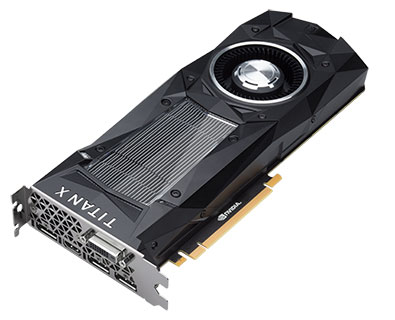 154
154
NVIDIA Titan X Pascal 12 GB Review
Architecture »Introduction

A flagship GPU launch by NVIDIA was the last thing we were expecting in the thick of Summer, especially given the market positioning of the GeForce GTX 1080, with some partners running riot with pricing (>$800 prices for some cards) and questionable market availability. NVIDIA managed to surprise us nonetheless by announcing its TITAN X Pascal graphics card barely 10 days ago, with market availability beginning 2nd August, 2016 and our review today.
The most interesting aspect about this brazenly expensive graphics card is its branding. You'll notice that NVIDIA dropped "GeForce GTX" from its model name, simply calling it the "TITAN X Pascal". This makes "TITAN" a consumer graphics brand unto itself. Only NVIDIA's third since GeForce and Riva. This achieves two things. First, it adds to the exclusivity of this SKU, elevating TITAN above GeForce. Second, it adds a bit of ambiguity to whom this product targets as a buyer, letting NVIDIA get away with its steep price tag.
NVIDIA changed tactics to the way it approaches expensive graphics cards with this generation. Earlier, the company would develop a performance-segment chip addressing sub-$600 price-points; and one "big chip" based on the architecture with which it powers high-end GeForce products and Quadro (professional graphics) and Tesla (HPC) products. NVIDIA would find itself with unused on-die components - such as FP64 (double-precision) CUDA cores that made their way to GeForce products - making up a bulk of company's sales for the silicon.
This is something NVIDIA is avoiding with the current generation by developing two "big chips", the GP100, which made its debut with the Tesla P100 HPC accelerator featuring FP64 CUDA cores and exotic HBM2 memory, and the newer GP102 silicon, which is designed keeping in mind consumer graphics and professional graphics applications that don't use double-precision compute. This chip also trades HBM2 for the more affordable GDDR5X memory.

The reviewed TITAN X Pascal is the first product based on the GP102 silicon. It physically features 3,840 CUDA cores spread across 30 streaming multiprocessors (SM) and six graphics processing clusters (GPCs) from which 3,584 are enabled on the TITAN X Pascal. The GP102 is in essence a 1.5X upscale of the GP104 silicon. Also featured are 224 TMUs, 96 ROPs, and a 384-bit wide GDDR5X memory interface holding 12 GB of memory.
Due to lack of any real competition from AMD in the current generation, NVIDIA gets to be cocky with its pricing. NVIDIA is pricing the TITAN X Pascal at a staggering $1,200. The company is directly marketing the card, doing away with add-in card (AIC) partners (eg: ASUS, EVGA, Zotac, etc.). The company is also supplying the card through the OEM channel, to pre-built gaming PC vendors (eg: CyberPowerPC, Alienware, etc.).
| Radeon R9 Fury X | GeForce GTX 980 Ti | GeForce GTX Titan X | GeForce GTX 1070 | GeForce GTX 1080 | Titan X Pascal | |
|---|---|---|---|---|---|---|
| Shader Units | 4096 | 2816 | 3072 | 1920 | 2560 | 3584 |
| ROPs | 64 | 96 | 96 | 64 | 64 | 96 |
| Graphics Processor | Fiji | GM200 | GM200 | GP104 | GP104 | GP102 |
| Transistors | 8900M | 8000M | 8000M | 7200M | 7200M | 12000M |
| Memory Size | 4 GB | 6 GB | 12 GB | 8 GB | 8 GB | 12 GB |
| Memory Bus Width | 4096 bit | 384 bit | 384 bit | 256 bit | 256 bit | 384 bit |
| Core Clock | 1050 MHz | 1000 MHz+ | 1000 MHz+ | 1506 MHz+ | 1607 MHz+ | 1418 MHz+ |
| Memory Clock | 500 MHz | 1750 MHz | 1750 MHz | 2002 MHz | 1251 MHz | 1251 MHz |
| Price | $600 | $440 | $1150 | $380 / $450 | $600 / $700 | $1200 |
Jan 27th, 2025 11:53 EST
change timezone
Latest GPU Drivers
New Forum Posts
- Gigabyte GTX1070 mini 0 Mhz GPU clock , 0 Mhz memory , 0 memory size (2)
- So who’s paying $100 for GTA 6 then? (44)
- 3D Printer Club (380)
- Is It The 1080 TI The Best GPU Ever? (232)
- Those old video card pin connectors (26)
- Windows 11 General Discussion (5632)
- Will you buy a RTX 5090? (171)
- ASUS TUF A15 FA507NVR (2024) Ryzen 7 7435HS + RTX 4060 8GB (2)
- HDMI Port on RX 470 breaks driver? (What) (6)
- Is my brand new monitor messed up or am I seeing things? (83)
Popular Reviews
- NVIDIA GeForce RTX 5090 Founders Edition Review - The New Flagship
- ASUS GeForce RTX 5090 Astral OC Review - Astronomical Premium
- NVIDIA GeForce RTX 5090 PCI-Express Scaling
- MSI GeForce RTX 5090 Suprim Liquid SOC Review
- MSI GeForce RTX 5090 Suprim SOC Review
- Palit GeForce RTX 5090 GameRock Review
- AMD Ryzen 7 9800X3D Review - The Best Gaming Processor
- NVIDIA DLSS 4 Transformer Review - Better Image Quality for Everyone
- Alphacool Apex 1 CPU Water Block Review - Performance King!
- NVIDIA GeForce RTX 5090 Founders Edition Unboxing
Controversial News Posts
- NVIDIA 2025 International CES Keynote: Liveblog (470)
- AMD Debuts Radeon RX 9070 XT and RX 9070 Powered by RDNA 4, and FSR 4 (349)
- AMD is Taking Time with Radeon RX 9000 to Optimize Software and FSR 4 (238)
- AMD Radeon RX 9070 XT & RX 9070 Custom Models In Stock at European Stores (226)
- NVIDIA GeForce RTX 5090 Features 575 W TDP, RTX 5080 Carries 360 W TDP (217)
- New Leak Reveals NVIDIA RTX 5080 Is Slower Than RTX 4090 (184)
- AMD's Radeon RX 9070 Launch Faces Pricing Hurdles (175)
- Potential RTX 5090 and RTX 5080 Pricing in China Leaks (173)